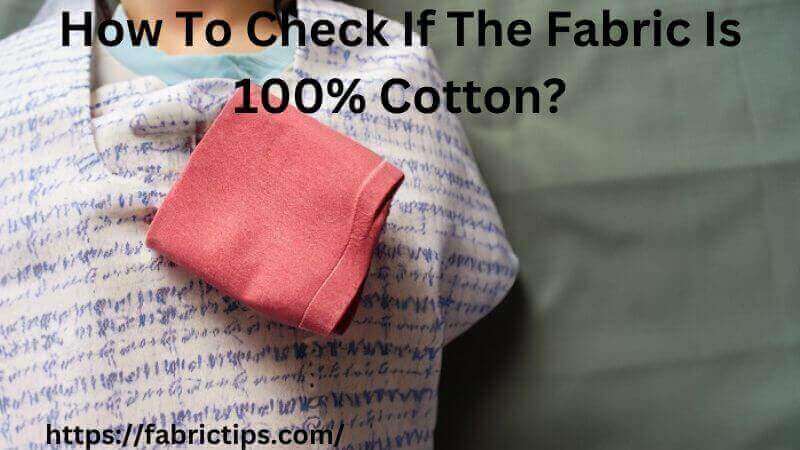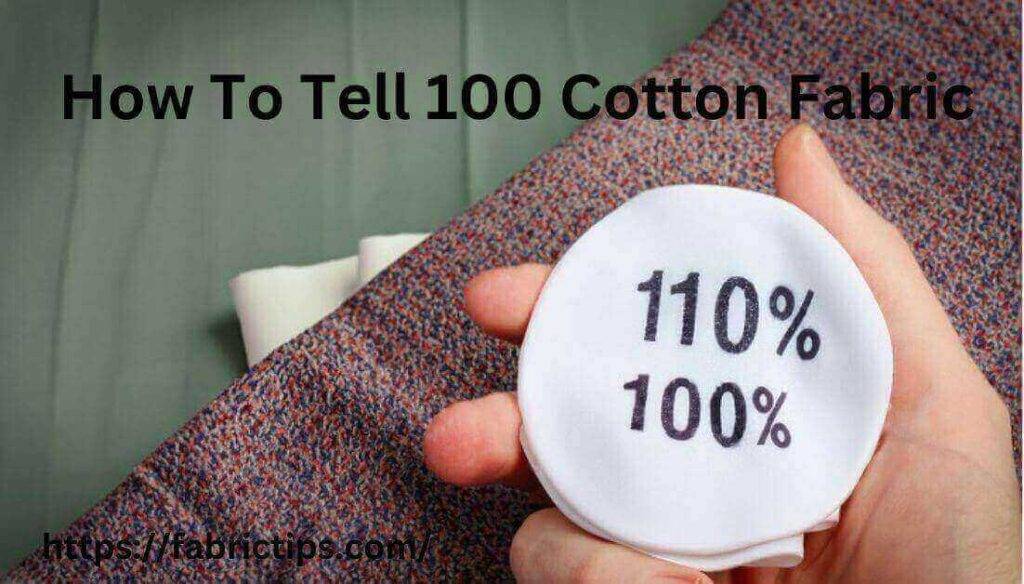Last Updated on June 24, 2023 by Wahid
Cotton continues to be king. The fabric is soft, comfortable, & feels like a friend after some break-in time. Additionally, it’s not as pricey as silk and other fabrics without sacrificing quality. On most days, there is nothing better than 100% cotton to relieve stress after a tough day.
How to tell 100 cotton fabric? Since 56% of fabrics contain some type of cotton, verify that a shirt or dress that says 100% cotton is really 100% cotton. Burn tests are an easy way to determine whether a garment is a pure or blended cotton. The easiest way to tell is to look for cotton that doesn’t curl or melt when a candle, lighter, or match is ignited. Be careful, there can be a burning smell and grayish ash is left behind without any indication of melting. Holding 100% cotton against your cheek is incredibly soft and tear-resistant.
However, the best way to tell whether your clothing is 100% cotton is to continue reading our article. Ensure that you only wear 100% cotton clothing by reading this article.
Exactly What Does 100% Cotton Mean?

If we want to find out whether a fabric is 100% cotton or not, we must first learn the essential details about 100% cotton. Cotton is a naturally breathable, soft, & hypoallergenic fabric, plus biodegradable due to its natural properties. There are 3 different cotton fabric weights, such as:
- Lightweight: Cotton that is lightweight and includes gingham, lawn, etc., which is perfect for summertime.
- Mediumweight: Cotton of medium weight is used for household textiles, such as quilts.
- Heavyweight: Lastly, there is heavyweight cotton, which includes denim, flannel, canvas, etc.
However, cotton fabrics are often blended with other fabrics like Polyester and Lycra. In most cases, cotton fabrics are tagged as 100% cotton and different methods can be used in order to test them. To get a better understanding of them, we have compiled them all into one place.
Fabric Testing: Why Should You Do It?

When you are unsure whether 100% cotton is important or not, you can clarify all your doubts here. The fabric should be tested before being used for various applications, which will be highlighted below:
- Wearability is the first & foremost reason. To make sure that cotton fabric won’t harm your skin and will be comfortable to wear. If you want to use 100% cotton fabric, you should definitely buy it. However, in order to make sure that you have the best fabric entirely made from cotton, you should test it before using it.
- Additionally, if your fabric is going to be used for applications without stretching, you should never use cotton fabrics that contain lycra blends. The fabric must also be tested at this point.
- Fabrics made with cotton blends demand different care than fabrics made with 100% cotton. Thus, it is equally important to know how to maintain the fabric.
- As 100% cotton is capable of withstanding more heat than poly-cotton. If you plan to iron your cotton dress on the highest setting, make sure it is 100% cotton instead of a blend.
- When it comes to carbon footprints and needing 100% cotton fabric for environmentally-friendly applications, 100% cotton fabric is definitely a good choice and should be tested.
How To Check If The Fabric Is 100% Cotton? – 3 Ways

With this knowledge of why you should test a fabric, there are 3 ways for you to determine whether it is 100% cotton or not. The following are the details:
- Test 100% Cotton With A Burn Test:
When it comes to checking whether the fabric is 100% cotton, burning is one of the simplest and most common methods. It is easy to tell whether a cotton fabric is 100% cotton or not based on its burning behavior. The steps are as follows:
- The lighter or matchbox should be held in one hand while the piece of fabric should be held in the other. As soon as the flame is lit, gently touch the fabric corner to the flame.
- There are 3 things you need to notice, such as the “way it burns,” “what it smells like,” and “ashes.”
- It smells like burning paper. Aside from this, after you extinguish the flame, an orange glow will remain.
- Burn it and see how it reacts. Cotton burns quickly and doesn’t melt, in contrast to blends.
- As the fabric burns to ashes, notice its ashes left over. 100% cotton ashes are extremely brittle; for this reason, a single touch will cause them to crumble.
- By punching the ashes, a bond will be formed between them. Additionally, water will dissolve the ashes of 100% cotton.
- In addition, if you are able to green-tick the following points, such as that the fabric melted, whether the ashes felt brittle, or whether they dissolved in water – so, it should be 100% cotton fabric.
2. Check 100% Cotton Without Burning [By Touching]
There can be a lot of stiffness in cotton, particularly in 100% cotton. Actually, this is especially true of quilting cotton, which is a medium-weight cotton that’s well-known for its durability. Fold lines can easily be indented and held due to their stiffness.
- Whether you use your fingers or not, there will be a mark on the fabric regardless. Fabrics usually soften after washing, but they still wrinkle easily. Various types of cotton fall into this category, ranging from light cotton for summer to heavy cotton for winter.
- You will feel cool, have a subtle texture, and your skin will feel soft against 100% cotton. For the best test of this, let your eyes close and press the fabric against your face, ideally against your cheeks.
- However, performing the test again on a different fabric, such as silk, for example, will result in a different result. In addition to feeling smooth, silk is slippery & cold.
- In comparison with 100% cotton, poly cotton, and polyester blends have a smoother feel and will be more comfortable to wear. There will be coarseness and scratchiness in wool.
- There is no stretch in fabrics made of 100% content. Although they have some give, most of the time, they are stiff materials that give shape to garments.
- When a fabric feels soft and cool on your body, keeps its shape, structured shape, & creases easily, it is most likely 100% cotton.
3. Check 100% Cotton By Washing It:
The cotton fabric can also be wet to determine whether it’s 100% cotton. As a result of cotton’s structural properties, cotton holds more water than silk or polyester and does not dry as quickly.
- Moreover, cotton fabrics can easily shrink when washed in hot water for the first time. Also, you can tell by looking at the cotton cloth after washing it, as 100% cotton fabrics can get crooked and wrinkled after washing.
- In addition to its slow drying rate, cotton also has a tendency to attract moisture. When it gets wet, when it dries, it retains water.
- There are fabrics that don’t absorb moisture, dry quickly, and are easy to clean. As cotton dries, it will become less pliable.
- Further, cotton will shrink when it is washed with hot water. Since it is made from natural materials, 100% cotton can shrink by 5% after being washed with hot water. As a plus, cotton stretches, which means hot water will not damage it.
- If there is a label on a fabric, it can be used to determine whether it is 100% cotton. However, sometimes you will find cotton that does not include a label.
When you have fabric like this at your house, you can perform the burn test. Another option is to get it wet and see if it works. In addition, cotton is soft & smooth to the touch.
How To Tell If Socks Are 100% Cotton

The softness of 100% cotton socks will make your feet feel comfortable. Due to cotton’s breathable properties, you will also be able to keep your feet cooler for longer.
- When you wear socks containing polyester, your legs will become clammy.
- Since polyester is naturally water-resistant, it does not absorb water.
- By blending with cotton, moisture cannot escape from the fabric as easily. Your feet will feel hot & sweaty as a result.
- Your socks’ price is also an indication of whether they contain 100 percent cotton.
- Buying cotton is often expensive. If you find socks at a great price, there is a chance they are cotton blends.
How To Tell If Shirts Are 100% Cotton

A 100% cotton shirt is both cool and comfortable, particularly when it’s warm outside. There is no doubt that cotton is an ideal fabric for hot climates since it evaporates moisture. When you wear cotton blend shirts, you are more likely to sweat and feel hot.
- Cotton has the disadvantage of being a slow-drying material. In terms of identifying fabrics, having this information can be useful. Timing how long it takes a shirt to dry if it is wet.
- If the content is 100% cotton, it will take a long time. A fast-drying fabric may be polycotton.
- Polycotton shirts feel smoother and silkier compared to 100% cotton shirts. In addition, it is less likely to wrinkle, which means you won’t have to iron it as often.
- You can tell if a shirt is 100% cotton by checking the label. In case that’s not possible, see how quickly the fabric dries & how it feels on you.
Before you buy, put it on first to feel the softness and texture. When it feels smooth as silk, chances are it’s blended.
100% Cotton Vs Polyester Blend: What’s Best?

The choice between polyester blends and 100% cotton will depend on the fabric and your personal preferences.
| 100% Cotton | Polyester Blend |
| Because cotton contains natural fibers, it is slightly more useful than synthetic fibers. | Polycotton comes from manmade synthetic fiber, it is not useful as natural fibers. |
| It is comfortable to wear cotton and less likely to cause skin irritations. | Fibers made from synthetics like polyester do not breathe. |
| Due to its skin-friendly properties, it is ideal for skin-contact garments. | Clothing made from synthetic materials can become sticky and hot in humid or warm climates. |
| Due to its ability to evaporate moisture, it prevents sweat accumulation on bedding and underwear. | Polyester blend keeps heat & sweat close to your body rather than allowing the moisture to escape. |
| When the weather is cooler, cotton helps keep warmth in since it is heavier compared to synthetic fabrics. | Conversely, polyester, because of its light and airy properties, can feel a bit cool. |
| Unfortunately, cotton isn’t cheap, actually expensive. | Cotton blends are therefore cheaper than pure cotton. |
| The problem with cotton is that it shrinks constantly. | Fortunately, polyester does not shrink constantly. |
| Whenever cotton is washed regularly, it can deteriorate faster, therefore 100% cotton can last less than those made from manmade fibers. | In warmer climates, polycotton blends can be hot & clammy, but it lasts longer than 100 cottons. |
By mixing the two, you get polycotton and, to some extent, a hybrid material. A mixture of polyester fibers and 100% cotton creates a breathable garment with some longevity. Additionally, due to its overall lightness, cotton-polyester blends will not wrinkle as much.
In the end, the choice between the two depends on your geographical location and how you plan to use the garment for. When choosing a garment that is meant to endure regular washing, choose a polycotton fabric. If you want to stay cool and comfortable during hot weather, 100 %cotton is the best choice.
Cotton Or Polyester Thread: How To Tell

Whenever you purchase thread, you’ll see on the label whether it’s 100% cotton or 100% polyester, or may even be a blend. It’s possible that if you’ve had the thread for quite a long, its sticky label may have fallen off. If that is the case, the thread will need to be tested.
- The fiber content of sewing thread is tested in the same way as that of cotton fabric. Burn tests should be conducted.
Step 1: Cut out a small bit of thread measuring approximately 6 inches long.
Step 2: Light it on fire and see what shade the smoke turns.
Step 3: Keep an eye on what the thread smells like and what it does in response to heat.
Step 4: Take a close look at the ash’s color.
- Melting occurs when a polyester thread is used. The silk thread shrinks or curls when exposed to flame.
- Threads made of 100% cotton do not curl when heated. A smell of burning wood or paper will be present, along with grayish ash.
In reality, just like with fabric burn tests, cotton is hard to distinguish from different plant-based textiles since they all behave similarly. Cotton thread or polyester thread, or a combination of the 2, has become the most popular thread for sewing. Therefore, the thread you use will probably be one of the two.
Characteristics Of Different Fabrics
Upon closer inspection of various fabrics, you can notice that they all possess many characteristics. By using this method, you can find out if your fabric is real cotton, and if not, from what other materials it was blended. Here are some of the most notable characteristics of different cotton types.
Cotton:- Cotton should feel stiff when you touch it. Your fingers should be strong enough to break it, as well as sturdy enough to fold it.
Silk:- Silk is extremely smooth as well as has a bright, lustrous appearance. The appearance alone usually makes it easy to determine whether something is made of 100% silk. Since silk fibers are so flexible, they are difficult to crease.
Wool:- Wool has a coarse texture, and sometimes you can feel fibers sticking out of the material. In some cases, pure wool feels rough or scratchy when touched. The natural fiber is also thicker than other fabrics, as natural fiber is thicker.
Polyester:- Polyester & rayon both have a smooth feel, and both add a touch of luster visually and practically as well. In some ways, it looks like silk but does not feel as luxurious.
Twill:- Twill has a coarse texture & should also feel diagonal to the touch. The fabric twill is commonly used in the clothing of all types.
Velvet And Pile:- These types of materials have a smooth surface when touched, although their structure is somewhat hairy. When you examine the material closely, it may also be apparent that it has many loops.
Therefore, using this guide will help you figure out if your fabric is blended with cotton or if it’s 100% cotton. If you are unsure, you might want to check with the store you purchased it from. Eventually, selecting a reputable retailer that sells only 100 percent cotton fabric or clothing might be the most reliable option for ensuring quality.
Why Mix Polyester With Cotton?
Using a combination of these 2 materials is a common technique for making an affordable fabric. In addition to being affordable, polyester is also durable. The fabric helps cotton clothing last longer by enduring repeated movement.
- For everyday wear, cotton is the most breathable fabric. During the summer, cotton fabrics absorb moisture, making them perfect for wearing.
- Polyester, on the other hand, repels water. Because of this, garments worn in humid or wet environments often use it.
- Polycotton’s breathability is determined by the ratio of the fabrics. Generally, polycotton is a solid, breathable fabric suitable for summer and hot weather.
- A different manufacturer uses different ratios of these 2 fabrics. In general, 65% cotton and 35% polyester are commonly used ratios when creating Polycot fabric.
Cotton Or Polycotton: What Is The Most Comfortable Fabric?
In terms of comfort, the 2 main factors are softness and breathability. Fabrics made of cotton are among the most highly breathable. In contrast, polycotton has slightly reduced breathability.
- Also, cotton becomes softer as it wears. During washing, the fibers relax and become pliable and weaker.
- Nevertheless, pure cotton fabrics are heavier compared to polycotton fabrics. In cotton, the fabric density is higher.
- In cotton, which grows naturally, fabric quality varies greatly. According to the crop quality that year, the quality of your cotton product will vary.
- The quality of the cloth does not differ dramatically, but the price is significantly different.
- There are some clothes made of pure cotton that are expensive. It indicates a more comfortable fabric of higher quality.
However, cheap cotton, which is often used to make dresses for everyday wear, contains lower-quality fibers. For these purposes, cotton & polycotton fabrics are pretty similar in comfort. Finally, the best choice, if you’re searching for lightness, would be cotton. Nevertheless, polycotton has a stiffer texture and can also handle the weight of beadwork better than cotton for fancy traditional garments.
In Summary
To summarize, a variety of methods are available. Using the label is the best way to determine how to tell 100 cotton fabric. Alternatively, if this isn’t possible, pay close attention to how the fabric feels and looks. Try wetting it and seeing how quickly it dries. When working with a fabric you currently own, perform a burn test as a last resort. However, like me, most people choose the burn test. Certainly, it’s easier, faster, and more precise than any other method.
If you enjoyed the article, please share your thoughts in the comments below. Was it helpful to you in identifying 100% cotton? Let me know.


